Versine
| Trigonometry |
|---|
 |
| Reference |
| Laws and theorems |
| Calculus |
| Look up versine or versed sine in Wiktionary, the free dictionary. |
The versine or versed sine is a trigonometric function found in some of the earliest (Sanskrit Aryabhatia,[1] Section I) trigonometric tables. The versine of an angle is 1 minus its cosine.
There are several related functions, most notably the coversine and haversine. The latter, half a versine, is of particular importance in the haversine formula of navigation.
Overview
The versine[3][4][5][6][7] or versed sine[8][9][10][11][12] is a trigonometric function already appearing in some of the earliest trigonometric tables. It is symbolized in formulas using the abbreviations versin, sinver,[13][14] vers, ver[15] or siv.[16][17] In Latin, it is known as the sinus versus (flipped sine), versinus, versus, or sagitta (arrow).[18]
Expressed in terms of common trigonometric functions sine, cosine, and tangent, the versine is equal to [math]\displaystyle{ \operatorname{versin}\theta = 1 - \cos \theta = 2\sin^{2}\frac\theta2 = \sin\theta\,\tan\frac\theta2 }[/math]
There are several related functions corresponding to the versine:
- The versed cosine,[19][nb 1] or vercosine, abbreviated vercosin, vercos, or vcs.
- The coversed sine or coversine[20] (in Latin, cosinus versus or coversinus), abbreviated coversin,[21] covers,[22][23][24] cosiv, or cvs[25]
- The coversed cosine[26] or covercosine, abbreviated covercosin, covercos, or cvc
In full analogy to the above-mentioned four functions another set of four "half-value" functions exists as well:
- The haversed sine[27] or haversine (Latin semiversus),[28][29] abbreviated haversin, semiversin, semiversinus, havers, hav,[30][31] hvs,[nb 2] sem, or hv,[32] most famous from the haversine formula used historically in navigation
- The haversed cosine[33] or havercosine, abbreviated havercosin, havercos, hac or hvc
- The hacoversed sine, hacoversine,[21] or cohaversine, abbreviated hacoversin, semicoversin, hacovers, hacov[34] or hcv
- The hacoversed cosine,[35] hacovercosine, or cohavercosine, abbreviated hacovercosin, hacovercos or hcc
History and applications
Versine and coversine
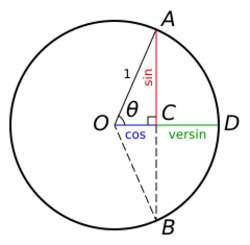
The ordinary sine function (see note on etymology) was sometimes historically called the sinus rectus ("straight sine"), to contrast it with the versed sine (sinus versus).[37] The meaning of these terms is apparent if one looks at the functions in the original context for their definition, a unit circle:
For a vertical chord AB of the unit circle, the sine of the angle θ (representing half of the subtended angle Δ) is the distance AC (half of the chord). On the other hand, the versed sine of θ is the distance CD from the center of the chord to the center of the arc. Thus, the sum of cos(θ) (equal to the length of line OC) and versin(θ) (equal to the length of line CD) is the radius OD (with length 1). Illustrated this way, the sine is vertical (rectus, literally "straight") while the versine is horizontal (versus, literally "turned against, out-of-place"); both are distances from C to the circle.
This figure also illustrates the reason why the versine was sometimes called the sagitta, Latin for arrow,[18][36] from the Arabic usage sahem[38] of the same meaning. This itself comes from the Indian word 'sara' (arrow)[citation needed] that was commonly used to refer to "utkrama-jya". If the arc ADB of the double-angle Δ = 2θ is viewed as a "bow" and the chord AB as its "string", then the versine CD is clearly the "arrow shaft".
In further keeping with the interpretation of the sine as "vertical" and the versed sine as "horizontal", sagitta is also an obsolete synonym for the abscissa (the horizontal axis of a graph).[36]
In 1821, Cauchy used the terms sinus versus (siv) for the versine and cosinus versus (cosiv) for the coversine.[16][17][nb 1]
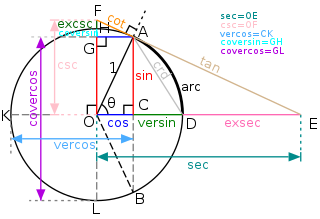
Historically, the versed sine was considered one of the most important trigonometric functions.[12][37][38]
As θ goes to zero, versin(θ) is the difference between two nearly equal quantities, so a user of a trigonometric table for the cosine alone would need a very high accuracy to obtain the versine in order to avoid catastrophic cancellation, making separate tables for the latter convenient.[12] Even with a calculator or computer, round-off errors make it advisable to use the sin2 formula for small θ.
Another historical advantage of the versine is that it is always non-negative, so its logarithm is defined everywhere except for the single angle (θ = 0, 2π, …) where it is zero—thus, one could use logarithmic tables for multiplications in formulas involving versines.
In fact, the earliest surviving table of sine (half-chord) values (as opposed to the chords tabulated by Ptolemy and other Greek authors), calculated from the Surya Siddhantha of India dated back to the 3rd century BC, was a table of values for the sine and versed sine (in 3.75° increments from 0 to 90°).[37]
The versine appears as an intermediate step in the application of the half-angle formula sin2(θ/2) = 1/2versin(θ), derived by Ptolemy, that was used to construct such tables.
Haversine
The haversine, in particular, was important in navigation because it appears in the haversine formula, which is used to reasonably accurately compute distances on an astronomic spheroid (see issues with the Earth's radius vs. sphere) given angular positions (e.g., longitude and latitude). One could also use sin2(θ/2) directly, but having a table of the haversine removed the need to compute squares and square roots.[12]
An early utilization by José de Mendoza y Ríos of what later would be called haversines is documented in 1801.[14][39]
The first known English equivalent to a table of haversines was published by James Andrew in 1805, under the name "Squares of Natural Semi-Chords".[40][41][18]
In 1835, the term haversine (notated naturally as hav. or base-10 logarithmically as log. haversine or log. havers.) was coined[42] by James Inman[14][43][44] in the third edition of his work Navigation and Nautical Astronomy: For the Use of British Seamen to simplify the calculation of distances between two points on the surface of the Earth using spherical trigonometry for applications in navigation.[3][42] Inman also used the terms nat. versine and nat. vers. for versines.[3]
Other high-regarded tables of haversines were those of Richard Farley in 1856[40][45] and John Caulfield Hannyngton in 1876.[40][46]
The haversine continues to be used in navigation and has found new applications in recent decades, as in Bruce D. Stark's method for clearing lunar distances utilizing Gaussian logarithms since 1995[47][48] or in a more compact method for sight reduction since 2014.[32]
Modern uses
Whilst the usage of the versine, coversine and haversine as well as their inverse functions can be traced back centuries, the names for the other five cofunctions appear to be of much younger origin.
One period (0 < θ < 2π) of a versine or, more commonly, a haversine (or havercosine) waveform is also commonly used in signal processing and control theory as the shape of a pulse or a window function (including Hann, Hann–Poisson and Tukey windows), because it smoothly (continuous in value and slope) "turns on" from zero to one (for haversine) and back to zero.[nb 2] In these applications, it is named Hann function or raised-cosine filter. Likewise, the havercosine is used in raised-cosine distributions in probability theory and statistics.
In the form of sin2(θ) the haversine of the double-angle Δ describes the relation between spreads and angles in rational trigonometry, a proposed reformulation of metrical planar and solid geometries by Norman John Wildberger since 2005.[49]
Mathematical identities
Definitions
| [math]\displaystyle{ \textrm{versin} (\theta) := 2\sin^2\!\left(\frac{\theta}{2}\right) = 1 - \cos (\theta) \, }[/math][4] | 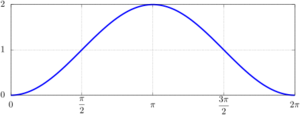
|
| [math]\displaystyle{ \textrm{coversin}(\theta) := \textrm{versin}\!\left(\frac{\pi}{2} - \theta\right) = 1 - \sin(\theta) \, }[/math][4] | 
|
| [math]\displaystyle{ \textrm{vercosin} (\theta) := 2\cos^2\!\left(\frac{\theta}{2}\right) = 1 + \cos (\theta) \, }[/math][19] | 
|
| [math]\displaystyle{ \textrm{covercosin}(\theta) := \textrm{vercosin}\!\left(\frac{\pi}{2} - \theta\right) = 1 + \sin(\theta) \, }[/math][26] | 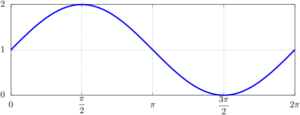
|
| [math]\displaystyle{ \textrm{haversin}(\theta) := \frac {\textrm{versin}(\theta)} {2} = \sin^2\!\left(\frac{\theta}{2}\right) = \frac{1 - \cos (\theta)}{2} \, }[/math][4] | 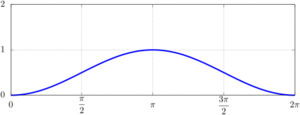
|
| [math]\displaystyle{ \textrm{hacoversin}(\theta) := \frac {\textrm{coversin}(\theta)} {2} = \frac{1 - \sin (\theta)}{2} \, }[/math][21] | 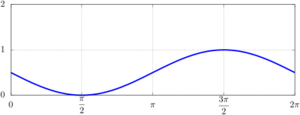
|
| [math]\displaystyle{ \textrm{havercosin}(\theta) := \frac {\textrm{vercosin}(\theta)} {2} = \cos^2\!\left(\frac{\theta}{2}\right) = \frac{1 + \cos (\theta)}{2} \, }[/math][33] | 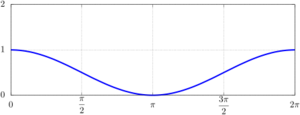
|
| [math]\displaystyle{ \textrm{hacovercosin}(\theta) := \frac {\textrm{covercosin}(\theta)} {2} = \frac{1 + \sin (\theta)}{2} \, }[/math][35] | 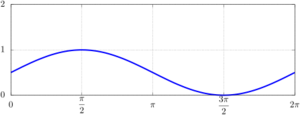
|
Circular rotations
The functions are circular rotations of each other.
- [math]\displaystyle{ \begin{align} \mathrm{versin}(\theta) &= \mathrm{coversin}\left(\theta + \frac{\pi}{2}\right) = \mathrm{vercosin}\left(\theta + \pi\right) = \mathrm{covercosin}\left(\theta + \frac{3\pi}{2}\right) \\ \mathrm{haversin}(\theta) &= \mathrm{hacoversin}\left(\theta + \frac{\pi}{2}\right) = \mathrm{havercosin}\left(\theta + \pi\right) = \mathrm{hacovercosin}\left(\theta + \frac{3\pi}{2}\right) \end{align} }[/math]
Derivatives and integrals
| [math]\displaystyle{ \frac{\mathrm{d}}{\mathrm{d}x}\mathrm{versin}(x) = \sin{x} }[/math][50] | [math]\displaystyle{ \int\mathrm{versin}(x) \,\mathrm{d}x = x - \sin{x} + C }[/math][4][50] |
| [math]\displaystyle{ \frac{\mathrm{d}}{\mathrm{d}x}\mathrm{vercosin}(x) = -\sin{x} }[/math] | [math]\displaystyle{ \int\mathrm{vercosin}(x) \,\mathrm{d}x = x + \sin{x} + C }[/math] |
| [math]\displaystyle{ \frac{\mathrm{d}}{\mathrm{d}x}\mathrm{coversin}(x) = -\cos{x} }[/math][20] | [math]\displaystyle{ \int\mathrm{coversin}(x) \,\mathrm{d}x = x + \cos{x} + C }[/math][20] |
| [math]\displaystyle{ \frac{\mathrm{d}}{\mathrm{d}x}\mathrm{covercosin}(x) = \cos{x} }[/math] | [math]\displaystyle{ \int\mathrm{covercosin}(x) \,\mathrm{d}x = x - \cos{x} + C }[/math] |
| [math]\displaystyle{ \frac{\mathrm{d}}{\mathrm{d}x}\mathrm{haversin}(x) = \frac{\sin{x}}{2} }[/math][27] | [math]\displaystyle{ \int\mathrm{haversin}(x) \,\mathrm{d}x = \frac{x - \sin{x}}{2} + C }[/math][27] |
| [math]\displaystyle{ \frac{\mathrm{d}}{\mathrm{d}x}\mathrm{havercosin}(x) = \frac{-\sin{x}}{2} }[/math] | [math]\displaystyle{ \int\mathrm{havercosin}(x) \,\mathrm{d}x = \frac{x + \sin{x}}{2} + C }[/math] |
| [math]\displaystyle{ \frac{\mathrm{d}}{\mathrm{d}x}\mathrm{hacoversin}(x) = \frac{-\cos{x}}{2} }[/math] | [math]\displaystyle{ \int\mathrm{hacoversin}(x) \,\mathrm{d}x = \frac{x + \cos{x}}{2} + C }[/math] |
| [math]\displaystyle{ \frac{\mathrm{d}}{\mathrm{d}x}\mathrm{hacovercosin}(x) = \frac{\cos{x}}{2} }[/math] | [math]\displaystyle{ \int\mathrm{hacovercosin}(x) \,\mathrm{d}x = \frac{x - \cos{x}}{2} + C }[/math] |
Inverse functions
Inverse functions like arcversine[34] (arcversin, arcvers,[8][34] avers,[51][52] aver), arcvercosine (arcvercosin, arcvercos, avercos, avcs), arccoversine[34] (arccoversin, arccovers,[8][34] acovers,[51][52] acvs), arccovercosine (arccovercosin, arccovercos, acovercos, acvc), archaversine (archaversin, archav,[34] haversin−1,[53] invhav,[34][54][55][56] ahav,[34][51][52] ahvs, ahv, hav−1[57][58]), archavercosine (archavercosin, archavercos, ahvc), archacoversine (archacoversin, ahcv) or archacovercosine (archacovercosin, archacovercos, ahcc) exist as well:
| [math]\displaystyle{ \operatorname{arcversin}(y) = \arccos\left(1-y\right)\, }[/math][34][51][52] |
| [math]\displaystyle{ \operatorname{arcvercos}(y) = \arccos\left(y-1\right)\, }[/math] |
| [math]\displaystyle{ \operatorname{arccoversin}(y) = \arcsin\left(1-y\right)\, }[/math][34][51][52] |
| [math]\displaystyle{ \operatorname{arccovercos}(y) = \arcsin\left(y-1\right)\, }[/math] |
| [math]\displaystyle{ \operatorname{archaversin}(y) = 2\arcsin\left(\sqrt{y}\right) = \arccos\left(1-2y\right)\, }[/math][34][51][52][53][54][55][57][58] |
| [math]\displaystyle{ \operatorname{archavercos}(y) = 2\arccos\left(\sqrt{y}\right) = \arccos\left(2y-1\right) }[/math] |
| [math]\displaystyle{ \operatorname{archacoversin}(y) = \arcsin\left(1-2y\right)\, }[/math] |
| [math]\displaystyle{ \operatorname{archacovercos}(y) = \arcsin\left(2y-1\right)\, }[/math] |
Other properties
These functions can be extended into the complex plane.[50][20][27]
- [math]\displaystyle{ \begin{align} \operatorname{versin}(z) &= \sum_{k=1}^\infty \frac{(-1)^{k-1} z^{2k}}{(2k)!} \\ \operatorname{haversin}(z) &= \sum_{k=1}^\infty \frac{(-1)^{k-1} z^{2k}}{2(2k)!} \end{align} }[/math]
- [math]\displaystyle{ \lim_{\theta \to 0} \frac{\operatorname{versin}(\theta)}{\theta} = 0 }[/math][8]
- [math]\displaystyle{ \begin{align} \frac{\operatorname{versin}(\theta) + \operatorname{coversin}(\theta)} {\operatorname{versin}(\theta) - \operatorname{coversin}(\theta)} - \frac{\operatorname{exsec}(\theta) + \operatorname{excsc}(\theta)} {\operatorname{exsec}(\theta) - \operatorname{excsc}(\theta)} &= \frac{2 \operatorname{versin}(\theta) \operatorname{coversin}(\theta)} {\operatorname{versin}(\theta) - \operatorname{coversin}(\theta)} \\[3pt] [\operatorname{versin}(\theta) + \operatorname{exsec}(\theta)]\, [\operatorname{coversin}(\theta) + \operatorname{excsc}(\theta)] &= \sin(\theta) \cos(\theta) \end{align} }[/math][8]
Approximations
When the versine v is small in comparison to the radius r, it may be approximated from the half-chord length L (the distance AC shown above) by the formula[59] [math]\displaystyle{ v \approx \frac{L^2}{2r}. }[/math]
Alternatively, if the versine is small and the versine, radius, and half-chord length are known, they may be used to estimate the arc length s (AD in the figure above) by the formula [math]\displaystyle{ s\approx L+\frac{v^2}{r} }[/math] This formula was known to the Chinese mathematician Shen Kuo, and a more accurate formula also involving the sagitta was developed two centuries later by Guo Shoujing.[60]
A more accurate approximation used in engineering[61] is [math]\displaystyle{ v\approx \frac{s^\frac{3}{2} L^\frac{1}{2}}{8r} }[/math]
Arbitrary curves and chords
The term versine is also sometimes used to describe deviations from straightness in an arbitrary planar curve, of which the above circle is a special case. Given a chord between two points in a curve, the perpendicular distance v from the chord to the curve (usually at the chord midpoint) is called a versine measurement. For a straight line, the versine of any chord is zero, so this measurement characterizes the straightness of the curve. In the limit as the chord length L goes to zero, the ratio 8v/L2 goes to the instantaneous curvature. This usage is especially common in rail transport, where it describes measurements of the straightness of the rail tracks[62] and it is the basis of the Hallade method for rail surveying.
The term sagitta (often abbreviated sag) is used similarly in optics, for describing the surfaces of lenses and mirrors.
See also
- Trigonometric identities
- Exsecant and excosecant
- Versiera (Witch of Agnesi)
- Exponential minus 1
- Natural logarithm plus 1
Notes
- ↑ 1.0 1.1 Some English sources confuse the versed cosine with the coversed sine. Historically (f.e. in Cauchy, 1821), the sinus versus (versine) was defined as siv(θ) = 1−cos(θ), the cosinus versus (what is now also known as coversine) as cosiv(θ) = 1−sin(θ), and the vercosine as vcsθ = 1+cos(θ). However, in their 2009 English translation of Cauchy's work, Bradley and Sandifer associate the cosinus versus (and cosiv) with the versed cosine (what is now also known as vercosine) rather than the coversed sine. Similarly, in their 1968/2000 work, Korn and Korn associate the covers(θ) function with the versed cosine instead of the coversed sine.
- ↑ 2.0 2.1 The abbreviation hvs sometimes used for the haversine function in signal processing and filtering is also sometimes used for the unrelated Heaviside step function.
References
- ↑ The Āryabhaṭīya by Āryabhaṭa
- ↑ Hackley, Charles W., ed (September 1855). The Mechanic's, Machinist's, Engineer's Practical Book of Reference: Containing tables and formulæ for use in superficial and solid mensuration; strength and weight of materials; mechanics; machinery; hydraulics, hydrodynamics; marine engines, chemistry; and miscellaneous recipes. Adapted to and for the use of all classes of practical mechanics. Together with the Engineer's Field Book: Containing formulæ for the various of running and changing lines, locating side tracks and switches, &c., &c. Tables of radii and their logarithms, natural and logarithmic versed sines and external secants, natural sines and tangents to every degree and minute of the quadrant, and logarithms from the natural numbers from 1 to 10,000. New York, USA: James G. Gregory, successor of W. A. Townsend & Co. (Stringer & Townsend). https://archive.org/details/mechanicsmachin01haslgoog. Retrieved 2017-08-13. "[…] Still there would be much labor of computation which may be saved by the use of tables of external secants and versed sines, which have been employed with great success recently by the Engineers on the Ohio and Mississippi Railroad, and which, with the formulas and rules necessary for their application to the laying down of curves, drawn up by Mr. Haslett, one of the Engineers of that Road, are now for the first time given to the public. […] In presenting this work to the public, the Author claims for it the adaptation of a new principle in trigonometrical analysis of the formulas generally used in field calculations. Experience has shown, that versed sines and external secants as frequently enter into calculations on curves as sines and tangents; and by their use, as illustrated in the examples given in this work, it is believed that many of the rules in general use are much simplified, and many calculations concerning curves and running lines made less intricate, and results obtained with more accuracy and far less trouble, than by any methods laid down in works of this kind. The examples given have all been suggested by actual practice, and will explain themselves. […] As a book for practical use in field work, it is confidently believed that this is more direct in the application of rules and facility of calculation than any work now in use. In addition to the tables generally found in books of this kind, the author has prepared, with great labor, a Table of Natural and Logarithmic Versed Sines and External Secants, calculated to degrees, for every minute; also, a Table of Radii and their Logarithms, from 1° to 60°. […]" 1856 edition
- ↑ 3.0 3.1 3.2 Navigation and Nautical Astronomy: For the Use of British Seamen (3 ed.). London, UK: W. Woodward, C. & J. Rivington. 1835. https://books.google.com/books?id=-fUOnQEACAAJ. Retrieved 2015-11-09. (Fourth edition: [1].)
- ↑ 4.0 4.1 4.2 4.3 4.4 Abramowitz, Milton; Stegun, Irene Ann, eds (1983). "Chapter 4.3.147: Elementary Transcendental Functions - Circular functions". Handbook of Mathematical Functions with Formulas, Graphs, and Mathematical Tables. Applied Mathematics Series. 55 (Ninth reprint with additional corrections of tenth original printing with corrections (December 1972); first ed.). Washington D.C.; New York: United States Department of Commerce, National Bureau of Standards; Dover Publications. pp. 78. LCCN 65-12253. ISBN 978-0-486-61272-0. http://www.math.sfu.ca/~cbm/aands/page_78.htm.
- ↑ "Background Notes on Measures: Angles". Cleave Books. 2004. http://www.cleavebooks.co.uk/dictunit/notesa.htm#others.
- ↑ "32.13. The Cosine cos(x) and Sine sin(x) functions - Cognate functions". An Atlas of Functions: with Equator, the Atlas Function Calculator (2 ed.). Springer Science+Business Media, LLC. 2009. p. 322. doi:10.1007/978-0-387-48807-3. ISBN 978-0-387-48806-6. https://archive.org/details/atlasfunctionswi00oldh_689.
- ↑ "Chapter 11.1. Sine and cosine properties". The Mathematical-Function Computation Handbook - Programming Using the MathCW Portable Software Library (1 ed.). Salt Lake City, UT, USA: Springer International Publishing AG. 2017-08-22. p. 301. doi:10.1007/978-3-319-64110-2. ISBN 978-3-319-64109-6.
- ↑ 8.0 8.1 8.2 8.3 8.4 "Review Exercises [100 Secondary Trigonometric Functions"]. written at Ann Arbor, Michigan, USA. Trigonometry. Part I: Plane Trigonometry. New York, USA: Henry Holt and Company / Norwood Press / J. S. Cushing Co. - Berwick & Smith Co., Norwood, Massachusetts, USA. January 1909. pp. 125–127. https://archive.org/stream/planetrigonometr00hallrich#page/125/mode/1up. Retrieved 2017-08-12.
- ↑ Clagett, Marshall, ed (1969). "5: Commentary on the Paper of E. J. Dijksterhuis (The Origins of Classical Mechanics from Aristotle to Newton)". Critical Problems in the History of Science (3 ed.). Madison, Milwaukee, and London: University of Wisconsin Press, Ltd.. pp. 185–190. 9780299018740. ISBN 0-299-01874-1. https://books.google.com/books?id=WboPReSZ668C. Retrieved 2015-11-16.
- ↑ "5 (Trigonometric Functions)". Precalculus: A Study of Functions and Their Applications. Harcourt Brace & Company. 1999. p. 344. http://math.hope.edu/swanson/text/chapter5.pdf. Retrieved 2015-11-12.
- ↑ "Appendix B: B9. Plane and Spherical Trigonometry: Formulas Expressed in Terms of the Haversine Function". Mathematical handbook for scientists and engineers: Definitions, theorems, and formulars for reference and review (3 ed.). Mineola, New York, USA: Dover Publications, Inc.. 2000. pp. 892–893. ISBN 978-0-486-41147-7. https://archive.org/details/mathematicalhand00korn_849. (See errata.)
- ↑ 12.0 12.1 12.2 12.3 "Trigonometry". 2007-09-14. http://www.du.edu/~jcalvert/math/trig.htm.
- ↑ (in German) Vorlesungen über Geschichte der Trigonometrie - Von der Erfindung der Logarithmen bis auf die Gegenwart. 2. Leipzig, Germany: B. G. Teubner. 1903. p. 231. https://books.google.com/books?id=2Kc_AQAAIAAJ. Retrieved 2015-12-09.
- ↑ 14.0 14.1 14.2 A History of Mathematical Notations. 2 (2 (3rd corrected printing of 1929 issue) ed.). Chicago, USA: Open court publishing company. 1952. p. 172. 1602067147. ISBN 978-1-60206-714-1. https://books.google.com/books?id=bT5suOONXlgC. Retrieved 2015-11-11. "The haversine first appears in the tables of logarithmic versines of José de Mendoza y Rios (Madrid, 1801, also 1805, 1809), and later in a treatise on navigation of James Inman (1821). See J. D. White in Nautical Magazine (February and July 1926)." (NB. ISBN and link for reprint of 2nd edition by Cosimo, Inc., New York, USA, 2013.)
- ↑ "德博士的 Notes About Circles, ज्य, & कोज्य: What in the world is a hacovercosine?". Hilo, Hawaii: University of Hawaii. http://www2.hawaii.edu/~tvs/trig.html.
- ↑ 16.0 16.1 "Analyse Algébrique" (in French). Cours d'Analyse de l'Ecole royale polytechnique. 1. L'Imprimerie Royale, Debure frères, Libraires du Roi et de la Bibliothèque du Roi. 1821.access-date=2015-11-07--> (reissued by Cambridge University Press , 2009; ISBN 978-1-108-00208-0)
- ↑ 17.0 17.1 Cauchy's Cours d'analyse: An Annotated Translation. Cauchy, Augustin-Louis. Springer Science+Business Media, LLC. 2010-01-14. pp. 10, 285. doi:10.1007/978-1-4419-0549-9. 1441905499, 978-1-4419-0549-9. ISBN 978-1-4419-0548-2. https://books.google.com/books?id=M0or-HGe7D0C. Retrieved 2015-11-09. (See errata.)
- ↑ 18.0 18.1 18.2 18.3 Heavenly Mathematics: The Forgotten Art of Spherical Trigonometry. Princeton University Press. 2013. 0691148929. ISBN 9780691148922. https://books.google.com/books?id=0BCCz8Sx5wkC&pg=PR7. Retrieved 2015-11-10.
- ↑ 19.0 19.1 "Vercosine". MathWorld. Wolfram Research, Inc.. http://mathworld.wolfram.com/Vercosine.html.
- ↑ 20.0 20.1 20.2 20.3 "Coversine". MathWorld. Wolfram Research, Inc.. http://mathworld.wolfram.com/Coversine.html.
- ↑ 21.0 21.1 21.2 "Hacoversine". MathWorld. Wolfram Research, Inc.. http://mathworld.wolfram.com/Hacoversine.html.
- ↑ Elements of Trigonometry with Logarithmic and Other Tables (3 ed.). Boston, USA: John Wiley & Sons. 1891. p. 33. https://archive.org/details/elementsoftrigon00ludlrich. Retrieved 2015-12-08.
- ↑ Plane Trigonometry (2 ed.). Boston, USA: Ginn and Company. 1903. p. 5. https://archive.org/details/planetrigonomet06wentgoog.
- ↑ Trigonometry. New York, USA: The Macmillan Company. 1913. pp. 8–9. https://archive.org/details/trigonometry01ingogoog. Retrieved 2015-12-08.
- ↑ Trigonometry: For Schools and Colleges. Boston, USA: Ginn and Company. 1896. p. 10. https://archive.org/details/trigonometryfor01roegoog. Retrieved 2015-12-08.
- ↑ 26.0 26.1 "Covercosine". MathWorld. Wolfram Research, Inc.. http://mathworld.wolfram.com/Covercosine.html.
- ↑ 27.0 27.1 27.2 27.3 27.4 "Haversine". MathWorld. Wolfram Research, Inc.. http://mathworld.wolfram.com/Haversine.html.
- ↑ "17, 18" (in German). Nautische Tafeln (24 ed.). Bremen, Germany: Arthur Geist Verlag. 1972.
- ↑ "Semiversus-Verfahren: Logarithmische Berechnung der Höhe" (in German). Hotheim am Taunus, Germany: Astrosail. 2015. http://www.astrosail.de/de/static/tutorial/semi2.php?cat=41.
- ↑ Plane Trigonometry. New York, USA: D. Van Nostrand Company. 1923. p. 42. https://books.google.com/books?id=G4O4AAAAIAAJ. Retrieved 2015-12-08.
- ↑ "Haversine". Wolfram Language & System: Documentation Center. 2008. http://reference.wolfram.com/language/ref/Haversine.html.
- ↑ 32.0 32.1 . Ix, Hanno"Ultra compact sight reduction". Ocean Navigator (Portland, ME, USA: Navigator Publishing LLC) (227): 42–43. July 2015. ISSN 0886-0149. http://issuu.com/navigatorpublishing/docs/on227_download_edition. Retrieved 2015-11-07.
- ↑ 33.0 33.1 "Havercosine". MathWorld. Wolfram Research, Inc.. http://mathworld.wolfram.com/Havercosine.html.
- ↑ 34.00 34.01 34.02 34.03 34.04 34.05 34.06 34.07 34.08 34.09 34.10 "Goniology" (in English). Eenheden, constanten en conversies. 2005-12-28. http://home.kpn.nl/vanadovv/Gonio.html.
- ↑ 35.0 35.1 "Hacovercosine". MathWorld. Wolfram Research, Inc.. http://mathworld.wolfram.com/Hacovercosine.html.
- ↑ 36.0 36.1 36.2 sagitta (3rd ed.), Oxford University Press, September 2005, http://oed.com/search?searchType=dictionary&q=sagitta (Subscription or UK public library membership required.)
- ↑ 37.0 37.1 37.2 A History of Mathematics (2 ed.). New York, USA: John Wiley & Sons. 1991-03-06. 0471543977. ISBN 978-0471543978. https://archive.org/details/historyofmathema00boye. Retrieved 2019-08-10.
- ↑ 38.0 38.1 "Earliest Known Uses of Some of the Words of Mathematics (V)". New Port Richey, Florida, USA. 2007-09-10. http://jeff560.tripod.com/v.html.
- ↑ (in Spanish) Memoria sobre algunos métodos nuevos de calcular la longitud por las distancias lunares: y aplicación de su teórica á la solucion de otros problemas de navegacion. Madrid, Spain: Imprenta Real. 1795. https://books.google.com/books?id=030t0OqlX2AC.
- ↑ 40.0 40.1 40.2 Archibald, Raymond Clare (1945). "Recent Mathematical Tables : 197[C, D].—Natural and Logarithmic Haversines...". Mathematical Tables and Other Aids to Computation 1 (11): 421–422. doi:10.1090/S0025-5718-45-99080-6.
- ↑ Astronomical and Nautical Tables with Precepts for finding the Latitude and Longitude of Places. T. XIII. London. 1805. pp. 29–148. (A 7-place haversine table from 0° to 120° in intervals of 10".)
- ↑ 42.0 42.1 Template:OED2
- ↑ "(unknown title)". Nautical Magazine. February 1926. (NB. According to Cajori, 1929, this journal has a discussion on the origin of haversines.)
- ↑ "(unknown title)". Nautical Magazine. July 1926. (NB. According to Cajori, 1929, this journal has a discussion on the origin of haversines.)
- ↑ Natural Versed Sines from 0 to 125°, and Logarithmic Versed Sines from 0 to 135°. London. 1856. (A haversine table from 0° to 125°/135°.)
- ↑ Haversines, Natural and Logarithmic, used in Computing Lunar Distances for the Nautical Almanac. London. 1876. (A 7-place haversine table from 0° to 180°, log. haversines at intervals of 15", nat. haversines at intervals of 10".)
- ↑ Stark Tables for Clearing the Lunar Distance and Finding Universal Time by Sextant Observation Including a Convenient Way to Sharpen Celestial Navigation Skills While On Land (2 ed.). Starpath Publications. 1997. 091402521X. ISBN 978-0914025214. http://www.starpath.com/catalog/books/1875.htm. Retrieved 2015-12-02. (NB. Contains a table of Gaussian logarithms lg(1+10−x).)
- ↑ "Bruce Stark - Tables for Clearing the Lunar Distance and Finding G.M.T. by Sextant Observation (1995, 1997)". Prague, Czech Republic. 2003-07-30. http://www.starpath.com/catalog/books/StarkTables.htm.[2][3]
- ↑ Divine Proportions: Rational Trigonometry to Universal Geometry (1 ed.). Australia: Wild Egg Pty Ltd. 2005. ISBN 0-9757492-0-X. https://archive.org/details/divineproportion0000wild. Retrieved 2015-12-01.
- ↑ 50.0 50.1 50.2 "Versine". MathWorld. Wolfram Research, Inc.. http://mathworld.wolfram.com/Versine.html.
- ↑ 51.0 51.1 51.2 51.3 51.4 51.5 "AUXTRIG". Greenbelt, Maryland, USA: NASA Goddard Space Flight Center. 2001-11-08. http://www.davidgsimpson.com/software/auxtrig_f90.txt.
- ↑ 52.0 52.1 52.2 52.3 52.4 52.5 "jass.utils Class Fmath". JASS - Java Audio Synthesis System. 2010-01-25. http://www.cs.ubc.ca/~kvdoel/jass/doc/jass/utils/Fmath.html#aexsec%28double%29.
- ↑ 53.0 53.1 mf344 (2014-07-04). "Lost but lovely: The haversine". Plus magazine (maths.org). http://plus.maths.org/content/lost-lovely-haversine.
- ↑ 54.0 54.1 "identify.py: An asteroid_server client which identifies measurements in MPC format". Fitsblink. 1999-03-01. http://www.fitsblink.net/software/clients/identify.py.
- ↑ 55.0 55.1 "astrotrig.py: Astronomical trigonometry related functions". Ljubljana, Slovenia: Telescope Vega, University of Ljubljana. 2014-10-27. http://astro.ago.fmf.uni-lj.si/podatki/2014/V2014-10-27/astro/bojan@arix.
- ↑ "Versine". Math Words, page 4. 2007-02-08. Versine. http://www.pballew.net/arithme4.html#versine.
- ↑ 57.0 57.1 "Inverse Haversine". MathWorld. Wolfram Research, Inc.. http://mathworld.wolfram.com/InverseHaversine.html.
- ↑ 58.0 58.1 "InverseHaversine". Wolfram Language & System: Documentation Center. 2008. http://reference.wolfram.com/language/ref/InverseHaversine.html.
- ↑ Geometry - Plane, Solid & Analytic Problem Solver. Problem Solvers Solution Guides. Research & Education Association (REA). December 1978. p. 359. ISBN 978-0-87891-510-1. https://books.google.com/books?id=4iNvcGB3M9sC&pg=PA359.
- ↑ Science and Civilisation in China: Mathematics and the Sciences of the Heavens and the Earth. 3. Cambridge University Press. 1959. p. 39. ISBN 9780521058018. https://books.google.com/books?id=jfQ9E0u4pLAC&pg=PA39.
- ↑ Table For Use in Computing Arcs, Chords and Versines. Chicago Bridge and Iron Company. 1930. p. 32.
- ↑ "Track measurement systems—concepts and techniques". Rail International (International Railway Congress Association, International Union of Railways) 3 (3): 159–166. 1972. ISSN 0020-8442. OCLC 751627806.
Further reading
- Hawking, Stephen William, ed (2002). On the Shoulders of Giants: The Great Works of Physics and Astronomy. Philadelphia, USA: Running Press. ISBN 0-7624-1698-X. https://archive.org/details/isbn_9780762413485. Retrieved 2017-07-31.
External links
- "Sagitta, Apothem, and Chord". The Wolfram Demonstrations Project. http://demonstrations.wolfram.com/SagittaApothemAndChord/.
- Trigonometric Functions at GeoGebra.org
 |





